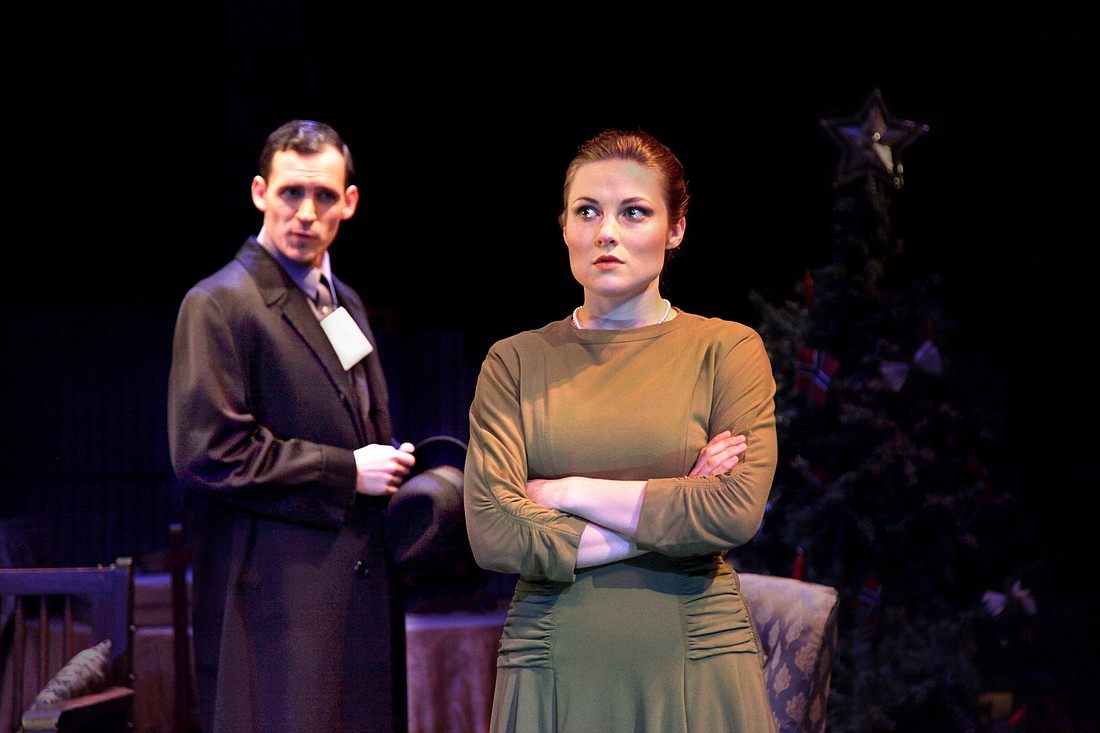- April 18, 2024
-
-
Loading

Loading

Ibsen’s “A Doll’s House” revolutionized theater. Filmmaker and playwright Ingmar Bergman revolutionized the original three-act play. He cut it down to 90 minutes, evicting minor characters, uprooting subplots and ironing out conversational flourishes. “Nora” is the result, and it’s the Asolo Conservatory’s latest production.
Bergman’s adaptation boils Ibsen’s play down to its essence. That essence is Nora, of course. When you first see her, Nora comes off as a spoiled, self-indulgent wife of a wealthy banker, namely Torvald Helmer (Mike Perez). He teases her for being a spendthrift; she responds with girlish flirtation. If you’re unfamiliar with the play, you might think Nora’s a Swedish Emma Bovary — a flighty character destined for doom. But Nora (Jessie Taylor) finds a way out that Emma never dreamed of. And the play quickly shows us the trap she’s in …
A few years back, Torvald was sickly. Thinking a rest cure in Italy would do the trick, Nora financed the vacation. She accomplished this by forging her father’s co-signature on a loan from a shady lawyer, Nils Krogstad (Rob Glauz). The couple took the trip and Torvald got better. In the years that followed, Nora scrimped and sacrificed. She slowly paid off the loan — in secret. Torvald thinks Nora’s late father paid for their sojourn. And now he’s just been promoted at his bank. His first act: firing the shady lawyer and hiring Nora’s struggling friend, Christine Linde (Danielle Renella), in his place.
Krogstad responds with blackmail. He knows the signature’s fake; he threatens to take Nora to court for fraud if he doesn’t keep his position. Nora intercedes for the rotter. But Torvald immediately fires him. Krogstad immediately writes a tell-all letter and puts it in the padlocked mailbox for Torvald to find. But Christine turns out to be Krogstad’s youthful flame. Helpful woman that she is, Christine agrees to finally marry him; Krogstad agrees to tear up the note and retrieve the letter before Torvald can read it. No, Christine says. The truth must come out if their marriage is to survive. Sounds nice. But it doesn’t work out that way.
This story proceeds with dreamlike inevitability. Credit Bergman for the dreaminess. His adaptation violates most beginning writers’ rules: Make every character speak with their own voice. Establish character motive through dialog. Bergman threw the rule book out the window and stripped out any pedestrian filler he could find. That includes Torvald’s icky endearment for Nora: “My little squirrel.” Icky yes, but a character clue as to why Nora felt trapped in a doll’s house. Strip away the pedestrian clues? Stuff happens because it happens. As it does in a dream — or an Ingmar Berman movie.
Dreamy material. But director Andrei Malaev-Babel still makes everything clear. He nicely punctuates the beats of the shortened story, and makes sure you hear the few throwaway lines of exposition. You know why Nora thinks she’s trapped in a doll house. You know her two options of escape. And, no, I don’t mean kick the mailbox off the wall and burn the letter. Speaking of which …
Kudos to set designer Derek Miller’s for the shiny, steel mailbox. It looks like a safe. His design for the Helmer family home looks like a claustrophobic, middle class dollhouse — a surreal space, surreally lit by Chris McVicker. Becki Leigh’s costumes instantly convey the class and self-image of the various characters.
The second-year students breathe life into Bergman’s re-imagined characters. Taylor’s Nora is not the flibbertigibbet of the original play. She’s a strong woman, finding out just how strong she is. Perez’ Torvald seems like a decent bloke—and not quite the over-controlling puppet master who’s trapped Nora in a gilded cage. Glauz’ Krogstad isn’t entirely indecent. Both the script and performance humanize him … a little. Jacob Sherburne’s character, Dr. Rank, regularly appears as Nora’s friend. He seems a little too friendly—as does she. As Christine, Renella does a fine job of interior acting—conveying the sense of a mind working, observing, thinking. The actor has little choice here. On the page, Renella’s character has two settings: moral disapproval and self-sacrifice.
Yes, a few of Bergman’s cuts are bone-deep. But his adaptation is a stronger play. He keeps a single-minded focus on Nora. It’s a cleaner structure. Although Nora’s change of mind is out of sight for most of the play.
Why?
My theory: Bergman thinks and writes like a filmmaker. The camera gets in your face, sees every micro-expression. One character says, “Are you happy?” The other character says, “Sure.” But a quick wince of the eyes tells you they’re lying.
Theater audiences don’t see with the clarity of a 65mm Panaflex camera. Here, it’s worth it to try. Read the subtext. Put yourself in Nora’s mind. Why does she hate her dollhouse life?
At the end of the play, Nora does what Emma Bovary could never do …
Not the fact that she walks out on her husband and children. That’s easy. The hard part is what happens inside her first .
Nora changes.
Put your mind in her dollhouse world and it all makes sense.